Reimagining capacity, equity, and resilience through Comprehensive Healthcare at Home
Canada’s hospitals are full, and the math no longer works. If demand for acute care continues to grow at its current pace, we will need to double hospital bed capacity—from roughly 75,000 to more than 150,000 beds—within the next decade. The cost of that expansion, in infrastructure alone, would exceed $300 billion and still fail to address our biggest constraint: people.
So the question is not how we build more hospitals—It’s how we build hospitals differently.
The Shift: From Bricks and Mortar to Distributed Capacity
Around the world, leading health systems have discovered that hospital-level care can safely move into the home. The NHS in England already operates more than 340 virtual wards programs with 7,653 virtual beds by March 2023 treating over 100,000 patients a year, freeing thousands of hospital beds without sacrificing outcomes. Australia’s “Hospital in the Home” program now delivers about 6% of all inpatient days outside the hospital, while Quebec’s Jewish General Hospital has demonstrated 93% patient satisfaction and a 46% reduction in staff requirements for its Hospital@Home pilot.
These results reveal an undeniable truth: the home is not a secondary site of care—it’s an extension of the hospital itself.
A Canadian Vision: The Hospital Without Walls
Imagine walking into a warehouse beside Toronto General Hospital—not one filled with beds, but with four hundred rugged Pelican cases labeled “Cardiac Ward in a Box”, “Respiratory Ward in a Box”, “Pediatric Ward in a Box.” Each case contains everything needed to deliver hospital-level treatment in the home: diagnostic equipment, sensors, infusion pumps, secure communications links, and digital monitoring tools—and doubles the capacity of TGH.
Now, imagine these portable wards paired with AI-driven predictive monitoring and the Care Unit workforce model developed through Comprehensive Healthcare at Home (CHAH)—24/7 interdisciplinary teams that use predictive data to focus time and expertise where it’s needed most.
This is not just an efficiency model. It’s an entirely new healthcare delivery architecture—one that doubles our hospital capacity without laying a single new brick.
How CHAH Makes It Work
CHAH Technology’s AI platform predictive intelligence extends the reach of hospital teams into homes across Canada.
- Predictive care: AI models anticipate deterioration before it happens—detecting infections, respiratory distress, or risk of a fall hours or days in advance.
- Real-time monitoring and dispatch: CHAH’s Operation Hub functions as a command center, triaging data from hundreds of patients and deploying nurses or paramedics within minutes.
- Integrated care records: Data flows seamlessly between hospital EHRs and community care, ensuring continuity and eliminating the information silos that cause adverse events.
- Dynamic staffing: Tight-knit Care Units deliver team-based care to defined client populations, providing stability and familiarity for patients and staff alike.
The result is a “hospital without walls”—where technology, workforce, and coordination replace the physical infrastructure of a ward.
Rural Reach and System Resilience
This model does more than add capacity. It creates access. Hospital-at-Home is uniquely suited to rural and remote regions, where building full acute facilities is neither feasible nor economical. With AI coordination, home monitoring, and community paramedicine integration, a nurse in Timmins or Thunder Bay could manage the same level of clinical oversight as one in Toronto.
It also builds pandemic resilience. During future surges—whether COVID-19, RSV, or influenza—these portable, distributed wards can absorb overflow safely, isolating patients at home while maintaining continuous medical supervision. In the next pandemic, we could pivot in days, not months.
A Call to Canada’s Hospital Leaders and Policymakers
The implications for Canada’s health system are profound:
- Doubling hospital capacity without new construction.
- Reducing costs per admission by 30–40%, as shown in international programs.
- Freeing existing hospital space for the most complex cases.
- Improving equity and access for rural and vulnerable populations.
Hospital at Home is not a pilot anymore—it’s a proven path forward. The question for Canada is whether we choose to lead or to follow.
A National Project Worthy of Our Ambition
Prime Minister Carney’s government has rightly called for nation-building through major projects in energy and infrastructure. But if we’re serious about building a stronger, more unified Canada, our greatest project must be healthcare reform itself.
Comprehensive Healthcare at Home offers the blueprint. With predictive AI, 24/7 Care Units, and portable “wards in a box,” we can transform hospitals from static institutions into dynamic networks of care—doubling our effective capacity while bringing care to where Canadians live.
The future of healthcare isn’t in building more hospitals. It’s in building a hospital that extends to every home.







